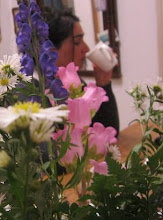Electronic Graphics
In the early 1960s digital computers became available to artists for the first time(although they cost from $100.000 to several millions, required air conditioning, and thereforelocated in separate computer rooms, uninhabitable 'studios';programs and data had to be prepared with the keypunch, punch cards then fed into the computer;systems were not interactive and could produce only still images).
The output medium was usually a pen plotter, microfilm plotter (hybrid bwn vector CRT and a raster image device), line printer or an alphanumeric printout, which was then manually transferred into a visual medium. read all
Herbert Franke (1927, de): Lichtformen, 1953-55:

Herbert Franke's wide-ranging interests include the use of random-number generators, image-processing, numerically-controlled machine tools, iterative techniques, fractals and even a series of experiments with music produced on the self-constructed wind instrumentof colleague Bruno Spoerri.
Now day many programs are avialable for people who want to program images, animation, and sound. program such as Processing: an open source programming language and environment
It is used by students, artists, designers, architects, researchers, and hobbyists for learning, prototyping, and production. It is created to teach fundamentals of computer programming within a visual context and to serve as a software sketchbook and professional production tool. Processing is developed by artists and designers as an alternative to proprietary software tools in the same domain. view Processing Flickr album
The EDSVJ project is driven by human heart: The instalation itself is using multiple inputs influencing algorythm parametres determinating the basic outlines of the final videosequence that can be seen. The experiment is technology-wise based on real-time inputs and proce55ing software. "this experiment is based on mine understanding of computer humanization.">>





5 comments:
thanks for posting this, especially the link to all the early things. the bell labs work in the 60's, while involving a ton of programming and time doing things that are now a breeze, still seems more human to me than what is currently being done with computers and art - and also more compelling (visually and with sound). i really think it is a different mindset, before more akin to working out ideas through limitations; whereas now, being seduced by technology's aethetics... working from the notion of what one WANTS to do rather than what the machine CAN do... looking at what one wants from these things as opposed to what they offer...i really appreciate the mention of franke's sound work which i had no idea about... you might like this, and this if you are interested in such things...
Sroden, i was pleased with the link you gave me, as well as very interested in many of the subjects at both your blogs, i'm certain i'm going to learn a lot from reading your bolgs
thanks
thanks for checking out the blogs, on airforms i tend to post things you will probably relate to, maps, charts, books, and the like... if you like ackermann's paintings as maps you might find my own work of interest - inbetweennoise.com, the old work was map based, the new work is more related to scores and self devised translation systems... yours is one of the few blogs i check regularly as there are always some good leads. would you mind if i added a link to it from airforms?
go ahead! with pleasure :)
steve, i like very much your paintings: the colors, the shapes.
and the way you create imaginary-real landscapes
Post a Comment